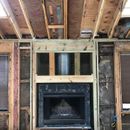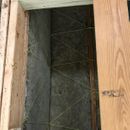Rockwool insulation vapor barrier inside chimney?
This is a story of one thing leading to another. When installing skylights in our living room, which required us to remove the sheetrock & insulation in the vicinity, we discovered that the ends of some of the ceiling joists were rotten (missing). This led us to notice the rotten top plate of the fireplace. We followed the damaged studs all the way down the wall. We reframed the face of the fireplace and am happy to say it is framing-inspector approved.
The inspector told us that he wanted to see (for the future rough insulation inspection) a vapor barrier on the Rockwool we used in the chimney chase. There was no insulation in the chase before… and we decided to go with Rockwool over fiberglass batt insulation (which would have had its own integrated vapor barrier of course) for this location. My question is this: what should we use for the vapor barrier? I can’t seem to find a clear answer online for this specific location inside the chimney case.
We are located in Atlanta and the home is a 1980 cedar-sided contemporary.
Thanks!
GBA Detail Library
A collection of one thousand construction details organized by climate and house part












Replies
You could staple on some MemBrain to keep the inspector happy. Much more important is what is your air barrier and air barrier testing plan?
Not sure just what your inspector is focusing on or worried about a vapor retarder in this location.
Jon R has it right: you need a non-combustible air barrier for the chimney chase, or the free space around the chimney. That is generally accomplished with metal flashing that is sealed with a fire-rated/high-temp sealant or mastic.